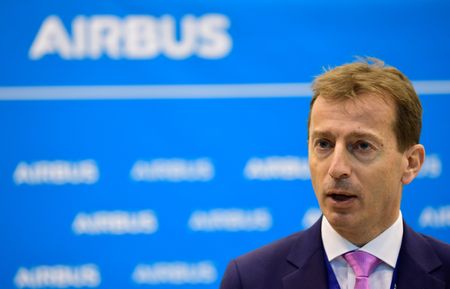

By Tim Hepher
PARIS (Reuters) -Europe’s Airbus on Friday gave the strongest hint yet that it plans to launch a bigger version of its 110 to 130-seat A220 passenger jet but said it would choose the timing carefully.
A stretched version of the lightweight Canadian-designed airplane makes a lot of sense, “but we don’t want to be right too early”, Chief Executive Guillaume Faury told investors.
The A220 was developed by Canada’s Bombardier in a bid to break into the main part of the jet market but struggled to keep up with the investments needed to challenge Airbus and U.S. rival Boeing and the project was sold to Airbus in 2018.
Airbus has in turn faced higher-than-expected costs on the loss-making programme but Chief Financial Officer Dominik Asam told investors it was on course to break even by mid-decade.
He reaffirmed Airbus production forecasts for larger A320neo jets. Airbus reported on Wednesday that Airbus was easing pressure on suppliers to reach the end-target of 75 a month by 2025 but was sticking for now to the headline goals.
Both executives were speaking at the company’s first formal Capital Markets Day for investors in four years.
Faury did not rule out a share buyback as Airbus rebuilds cash reserves depleted by what he called the “existential crisis” of COVID-19, but cautioned “we are not there yet”.
Airbus shares rose around 2% in early trading.
WIDE-BODY GAP
An A220-500 would begin the process of replacing the 150-seat-plus A320neo, the European company’s cash cow and a major battleground in the transatlantic war for sales with Boeing.
Airbus has seized a commanding lead in the main part of the single-aisle market, most recently through the larger A321neo which Asam said would have an increasing proportion of sales.
However, the industry’s biggest single-aisle variant, the delayed A321XLR, is not emerging as quickly as Airbus hoped.
Although Airbus was born as a producer of wide-body long-haul jets with the A300, which took flight 50 years ago next month, its biggest commercial success by far has been in workhorse single-aisle jets made popular by budget carriers.
Improvements in the range of the largest single-aisle jets like the A321neo have eaten into the lower end of the market traditionally reserved for bigger wide-body jets, where Boeing has for decades widely been seen as the market leader.
Faury signalled a broad attempt by Airbus to build up a position in big jets comparable to its success on narrow-body models, starting with a push to market the new A350 Freighter.
Boeing currently dominates large freighter sales and has so far outsold the A350 Freighter with its future 777X Freighter.
(Reporting by Tim Hepher; Editing by GV De Clercq and Edmund Blair)

